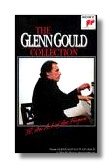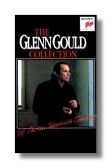
The Internet's Premier Classical Music Source
Related Links
- Latest Reviews
- More Reviews
-
By Composer
-
Collections
DVD & Blu-ray
Books
Concert Reviews
Articles/Interviews
Software
Audio
Search Amazon
Recommended Links
Site News
 VHS Review
VHS Review
The Glenn Gould Collection

Volume 13: The Goldberg Variations
- Johann Sebastian Bach: Goldberg Variations
Sony Classical SHV48424 VHS 58:33


Volume 14: The Question of Instrument
- Johann Sebastian Bach:
- Contrapunctus 1 from The Art Of Fugue
- Chromatic Fantasy
- Partita #4
Sony Classical SHV48425 VHS 57:47


Volume 15: An Art of the Fugue
- Johann Sebastian Bach:
- Contrapuncti 2, 4 & 15 from The Art Of Fugue
- The Well-Tempered Clavier Book 2: Fugues 9 and 22, Prélude and Fugue #19
- Three Part Invention #1
Sony Classical SHV48426 VHS 58:10


Volume 16: On The Twentieth Century
- Alexander Scriabin: Désir and Caresse dansée
- Arnold Schoenberg: Suite for Piano: Intermezzo
- Paul Hindemith: Sonata for Trumpet and Piano (Mvts. 1 & 3)
- Anton Webern: Concerto for Nine Instruments (excerpt)
Raymond Crisera, trumpet
Boris Brott, cond.
Sony Classical SHV48427 VHS 58:22
In 1992 Sony Classical brought out its first twelve installments of The Glenn Gould Collection, a home video series culled from the late pianist's CBC television appearances. Here is their long-awaited sequel, which includes a twentieth century anthology and the three-part series filmed towards the end of the pianist's life, Glenn Gould Plays Bach.
Two of these Bach programs, The Question of Instrument and An Art of the Fugue, find Glenn Gould in his preferred element, playing and talking to an audience of one. As Gould readily admitted, these off-the-cuff conversations, with director Bruno Monsaingeon dutifully playing the role of interlocator, were pre-planned down to the last word. But what words!
Gould's verbal brilliance, as well as his propensity for intellectual mischief, is in full flower as he discusses such topics as Bach's evolution as a fugue writer and the suitability of Bach's keyboard music on the concert grand. Ideas are illustrated with numerous examples at the piano, rendered in inimitably Gouldian fashion – the pianist hunched over low on his dilapidated chair, humming along, conducting with whichever hand is free. Beyond these eccentricities, one picks up on the qualities that made Gould so unique: his hair trigger rhythm and acute sense of timing, his ability to give shape and meaning to the thickest contrapuntal textures, at any given tempo. More revealing, perhaps, is the degree to which Gould's Bach interpretations grew more concentrated, emotionally intense, and pointed in detail in his last years. Note, for instance, how the stark theatrics of the Fourth Partita contrast to the pianist's relatively sedate tempo relationships in his 1963 commercial recording. The exhilarating Bb minor fugue from The Well-Tempered Clavier, Book 2 gets a more pointed and characterized reading here than in Gould's other versions . While I find the pianist's deliberation in the E Major Fugue from Book 2 and the unfinished Contrapunctus 15 from The Art Of Fugue – agonizingly drawn out to the point of caricature, the overall structure is miraculously sustained throughout.
Of the three Bach films, however, I suspect the eagerly awaited Goldberg Variations video will command the widest appeal. Taped in 1981, this is essentially a video record of Gould in the recording studio, re-recording the work that launched his international career. Monsaingeon shoots each of the thirty variations from a different angle, thereby creating a visual counterpart borne out of the music's architecture. More tellingly, the camera reveals the sheer joy and concentration exuded by a great performer at the peak of his powers. Pianophiles will be able to scrutinize Gould's idiosyncratic physical approach to piano playing in greater detail here than in other Gould videos. While his gesticulation may have grown more exaggerated over the years, he maneuvers his way through the treacherous cross-handed variations with the utmost of physical economy. Interestingly, Gould claimed that he never used the sustain pedal in Bach, yet there's his right foot pumping away, albeit discreetly.
Viewers who prefer more freedom in the ornaments, and the full inventory of repeats (Gould recaps only the "A" sections of the canons and the fugue-like variations), may wish to investigate András Schiff's fluid and imaginative 1993 live performance on a Teldec video. No one who cares about this music, however, can afford to miss Gould's blazingly original interpretation, which is even more compelling now that we can see as well as hear it. Gould's renown as a Bach specialist sometimes obscured the wide range of his catholic repertoire, especially in regard to twentieth century music. His predilection for counterpoint partly explained his early passion for the Second Viennese school of Schoenberg, Berg, and Webern, as well as his lifelong obsession with Richard Strauss' elaborately upholstered tone poems and operas. Volume 16 of the Glenn Gould Collection, On The Twentieth Century, compiles performance and conversation excerpts from two sources. One of these was a 1966 BBC series Conversations with Glenn Gould, from which short clips were extracted from complete shows respectively devoted to Schoenberg and Strauss. The format, in fact, was strikingly similar to the Bach shows under review. In one clip, for instance, we catch the pianist mid-phrase, expounding on the stylistic consistency of early and late Strauss, demonstrating his point by way of brilliantly "de-orchestrating" Ein Heldenleben. While these Gouldian sound-bytes are certainly fun to have, they make better sense in the larger context of the shows from which they were extrapolated.
In contrast, the Scriabin, Schoenberg, and Hindemith items taken from Gould's short lived mid-seventies CBC series Music In Our Time stand easily on their own as performances. But why does Sony only give us a smidgen from the first movement of Webern's Concerto for Nine Instruments ? After all, the Concerto was televised complete, and issued as such on CD in Sony's Glenn Gould Edition. Editorial decisions notwithstanding, rabid Gouldians will certainly want to add this volume to their collections, although normal people will do just as well renting it at Tower. Michael Stegemann's annotations put these films in perspective, and manage that rare combination of being both scholarly and readable.
Copyright © 1996, Jed Distler
(Published in Classical Pulse, February 1995 in slightly altered form)















